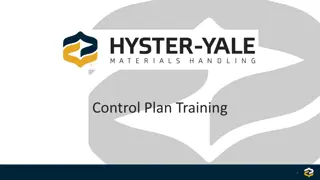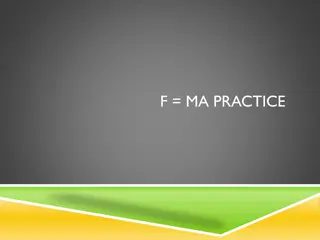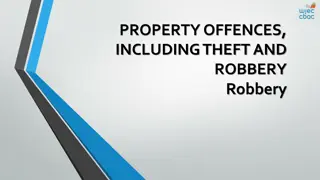Comprehensive Training on Use of Force and Control Tactics
This comprehensive training focuses on legal concepts, civil liability, critical decision-making, de-escalation techniques, and sound control tactics in relation to the use of force and control tactics. Emphasis is placed on the sanctity of human life, proportionality (legally and ethically justified), constitutional rights (4th Amendment), and relevant statutes governing law enforcement actions, particularly in Pennsylvania. The content highlights the justified use of force by peace officers in making arrests, including the conditions under which deadly force may be employed.
Download Presentation

Please find below an Image/Link to download the presentation.
The content on the website is provided AS IS for your information and personal use only. It may not be sold, licensed, or shared on other websites without obtaining consent from the author.If you encounter any issues during the download, it is possible that the publisher has removed the file from their server.
You are allowed to download the files provided on this website for personal or commercial use, subject to the condition that they are used lawfully. All files are the property of their respective owners.
The content on the website is provided AS IS for your information and personal use only. It may not be sold, licensed, or shared on other websites without obtaining consent from the author.
E N D
Presentation Transcript
Use of Force and Control Tactics Training
Use of Force and Control Tactics Training Focus Review legal concepts relating to use of force Discuss civil liability Utilize critical decision-making practices Continue to employ de-escalation techniques Practice sound control tactics 2
Use of Force and Control Tactics Sanctity of Human Life The need for law enforcement to protect themselves, members of the public, and, whenever possible, criminal suspects and subjects in crisis from danger and harm. 3
Use of Force and Control Tactics Proportionality: Legally Justified & Ethically Justified Legally Justified:, Justification of force used through application of Federal & State laws for the given circumstances Ethically Justified:, Reasonable application of force used with conscious thought & concern given to the circumstances 4
Use of Force and Control Tactics Legally Justified U.S. CONSTITUTION. 4THAmendment. to be free from the use of excessive force . 5
Use of Force and Control Tactics Legally Justified 2016 Pennsylvania Consolidated Statutes. Title 18 - CRIMES AND OFFENSES. Chapter 5 - General Principles of Justification. Section 508 - Use of force in law enforcement. 6
Use of Force and Control Tactics Legally Justified Section 508 (a) (1) - Peace officer s use of force in making arrest: A peace officer need not retreat or desist from efforts to make a lawful arrest because of resistance or threatened resistance to the arrest. A peace officer is justified in the use of any force believed to be necessary to effect the arrest. A peace officer is justified in the use of any force which he believes to be necessary to defend himself or another from bodily harm while making the arrest 7
Use of Force and Control Tactics Legally Justified Section 508 (a) (1) - Peace officer s use of force in making arrest: A peace officer is justified in using deadly force only when he/she believes that such force is necessary to prevent death or serious bodily injury to him/herself or others OR when he/she believes both that: o Such force is necessary to prevent the arrest from being defeated by resistance or escape AND o The person to be arrested has committed or attempted a forcible felony or is attempting to escape and possesses a deadly weapon, or otherwise indicates that he will endanger human life or inflict serious bodily injury unless arrested without delay. 8
Use of Force and Control Tactics Legally Justified Section 508 (a) (2) - Peace officer s use of force in making arrest: A peace officer making an arrest pursuant to an invalid warrant is justified in the use of any force which he/she would be justified in using if the warrant were valid, unless he/she knows that the warrant is invalid 9
Use of Force and Control Tactics Legally Justified Section 508 (c) (1) - Use of force regarding escape A peace officer who has an arrested or convicted person in his/her custody is justified in the use of such force to prevent the escape of the person from custody as the officer would be justified in using under subsection (a) if the officer were arresting the person. Section 508 (c) (2) - Use of force regarding escape A peace officer is justified in the use of such force, including deadly force, which the officer believes to be necessary to prevent the escape from a correctional institution of a person whom the officer believes to be lawfully detained in such institution under sentence for an offense or awaiting trial or commitment for an offense. 10
Use of Force and Control Tactics Review Department Policy Does your department have a current use of force policy? Does your department have current arrest policies? What actions are acceptable? What actions are unacceptable? Are ALL officers aware of and familiar with these policies? 11
Use of Force and Control Tactics Ethically Justified The conscious consideration of circumstances surrounding the situation at hand. 12
Use of Force and Control Tactics Emotional Intelligence Self Awareness Self Management Social Awareness Relationship Management 13
Use of Force and Control Tactics Contact Maturity What s really going on here What s going on internally with the person Avoid authoritarian action 14
Use of Force and Control Tactics Civil Liability Title 42 US Code 1983 Facts to be proven in a civil action: 1. The defendant had a duty; 2. The defendant breached that duty; 3. There was a causal connection between the breach of the duty and the injury; and 4. The injury to the plaintiff resulted from that breach. 15
Use of Force and Control Tactics Vicarious Liability Vicarious liability is a situation in which one party is held partly responsible for the unlawful actions of a third party. 16
Use of Force and Control Tactics Duty to Intervene A police officer is under a duty to intercede and prevent fellow officers from subjecting a citizen to excessive force and, may be held liable for his failure to do so if he observes the use of force and has sufficient time to act to prevent it. Figueroa v. Mazza 825 F.3d 89, 106 (2d Cir. 2016) 17
Use of Force and Control Tactics Qualified Immunity Protects a government official from lawsuits alleging that the official violated a plaintiff's rights, only allowing suits where officials violated a clearly established statutory or constitutional right. 18
Use of Force and Control Tactics Tennessee v. Garner, 471 U.S. 1 (1985) Deadly force is considered a seizure under the 4th Amendment. A police officer may not seize an unarmed, non- dangerous person by shooting him dead. An officer can justifiably use deadly force if the officer believes that a suspect poses a significant threat of death or serious bodily injury to the officer or others. 19
Use of Force and Control Tactics Graham v. Connor, 490 U.S. 386 (1989) Reasonableness must be judged from the perspective of a reasonable officer on the scene: Seriousness of the offense Immediate threat to the officer or others Resisting a lawful arrest Fleeing a lawful arrest 20
Use of Force and Control Tactics Critical Decision-Making Model (CDM) Collect information 1. Collect information 2. Assess situation, threats & risks Assess the situation, threats, & risks Act, review, & re-assess ETHICS 3. Consider police powers & agency policy VALUES 4. Identify options & determine best course of action PROPORTIONALITY SANCTITY OF HUMAN LIFE 5. Act, review & re-assess Consider police powers & agency policy Identify options & determine the best course of action 21
Use of Force and Control Tactics Benefits of the CDM Helps officers to organize their decision- making process and reach better decisions Helps officers to explain their actions after the fact 22
Use of Force and Control Tactics De-escalation Requires cooperation Is not something you do to a person Recognize, create, and maintain conditions that allow de-escalation of one s own emotions 23
Use of Force and Control Tactics Containment & Control Containment: Priority Limit movement Slow down and focus on de-escalation Control: Establish scene control Recognize officer s decision to de-escalate tied to agency and community support 24
Use of Force and Control Tactics Contact & Communication Contact: Subject and officer are willing to engage in verbal de- escalation Subject understands the officer Recognize if contact can be established Communication: Requires competency in emotional intelligence, patience, and skill Utilize persuasive communication 25
Use of Force and Control Tactics Active Listening Use I statements Engage with open-ended questions Employ the mirroring technique Paraphrase what you heard Consider your body language 26
Use of Force and Control Tactics Communication Dos & Don ts Stop saying Relax or Calm Down" - DoesNOT work! Say instead Try breathing with me or Take a deep breath with me Don t draw a line in the sand Avoid being condescending Use first names when addressing the person 27
Use of Force and Control Tactics Ensuring Positive Outcomes Are you practicing the basics of your craft? Do you know the law? Criminal and civil? Is the use of force proportional? Are you practicing the CDM? How sharp are your communication skills? Are officers working together as a team? 28
Use of Force and Control Tactics Control Tactics Review 29
Use of Force and Control Tactics Handcuff Selection 30
Use of Force and Control Tactics Basic Handcuffing Concepts It is important to gain control of the subject from the first touch Apply handcuffs smoothly & quickly Pistol Grip Double Push Principle Double Lock Cuffs Check for Tightness 31
Use of Force and Control Tactics Officer Positioning 32
Use of Force and Control Tactics Reactionary Gap The minimum safe zone that an officer should maintain when dealing with others. 33
Use of Force and Control Tactics Rules for Practical Class NO LIVE FIREARMS, CHEMICAL AGENTS, KNIVES, OR ANY OTHER WEAPONS ARE ALLOWED. Instructors/ Students will participate in a check for weapons prior to start of physical practice. DISRUPTIVE BEHAVIOR WILL NOT BE TOLERATED. 35
Use of Force and Control Tactics Rules for Practical Class Prior to training: Shower No cologne/perfumes Trim fingernails Remove all jewelry 36
Use of Force and Control Tactics Rules for Practical Class - Instructors - Create a safe training environment Maintain discipline Students: Follow instructions Train in a safe professional manner Advise of any pre-existing injuries or health conditions to be taken into consideration Participate to the level of your ability 37
Use of Force and Control Tactics Rules for Practical Class Students: Exercise good judgement No horseplay or aggressive actions which might cause injury to a student or instructor will be tolerated Position yourself on the training mats properly when practicing techniques to avoid injury. Injuries must be reported to the instructor immediately 38
Use of Force and Control Tactics Rules for Practical Class Students: All students are safety officers: Any condition that is unsafe must be reported to the instructor. All injuries, no matter how slight, must be reported to the instructor as soon as possible after they occur; but no later than the end of class. Please Respect The Rules. 39
Use of Force and Control Tactics SAFETY CHECK!! Warm-Up 40
Use of Force and Control Tactics Practical Application Effective Control for Better Outcomes 41























